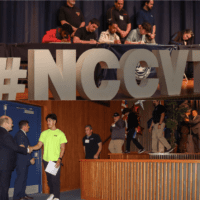

Delaware is investing in career readiness and many other areas with their more than $600 million in COVID relief ESSER funds.
Delaware is spending more of its education COVID relief funds on postsecondary and career readiness than other states.
“Overall, Delaware’s state spending aligns with national trends, but we are seeing more of a priority in those areas in Delaware than in other states, so that’s one thing that really stands out,” said Austin Estes, project director for the COVID Relief Data Project.
Estes spoke at a Tuesday webinar, entitled “Where is the COVID education money now?” It was the last of a two-part series sponsored by First State Educate, a local education advocacy group.
RELATED: Here’s how $600M in COVID education money was spent
The project was launched by the Council of Chief State School Officers to research and analyze how states are using federal dollars to state education agencies through the Elementary and Secondary School Emergency Relief Fund.
For a comprehensive list of how much money each Delaware school district spent, click here.
The webinar was designed to analyze and digest where and how Delaware spent the $637,239,246 of school emergency relief funds that they were given, an “insane” amount of money, said Laurisa Schutt, executive director of First State Educate.
$122 billion was distributed nationally and allocated in three rounds:
- In March 2020, as part of the Coronavirus Aid, Relief and Economic Security, or CARES Act, Delaware received $43,492,752.
- In December 2020, as part of the Coronavirus Response and Relief Supplemental Appropriations Act, Delaware received $182,885,104.
- In March 2021, through the American Rescue Plan Act, Delaware received $410,733,965.
All that money needs to be spent by 2024.
The state has control of only about 10% of the education relief funds, with most going to districts to spend on the areas they’ve identified within their system.
The state has used its share to address staff vacancies, after-school programs, college prep programs, learning loss and technological access.
It has spent $10 million on programs outside of class time, such as wraparound services including before- and after-school care.
The state has spent $5 million to address remote learning and the digital divide.
“This greatly expands access to digital books in the state library system,” Estes said.
Another $5 million was spent to fund tutors for students who have experienced learning loss due to the pandemic.
Delaware put $3.5 million into retention bonuses for bus drivers as the state grapples with a shortage.
It also spent $2.5 million to support postsecondary and career readiness through advising and college prep programs.
Nationally, the top 10 areas where states have spent their money are:
- $4.18 billion on tutoring services
- $2.83 billion on extended school services
- $1.98 billion on local supplement
- $1.44 billion on school personnel
- $1.32 billion on curriculum and instruction
- $1.13 billion on remote learning and the digital divide
- $1.10 billion on mental health services
- $577 million on postsecondary and career readiness
- $501 million on administration
- $398 million on equity and targeted supports
Delaware has been a leader in career and technical education and career readiness for years, Estes said.
“So a lot of Delaware’s ESSER money is also going to support college and career readiness,” she said.
Cara Candal, managing director of policy at ExcelinEd, said Delaware needs to follow up and make sure the programs they fund are operating as planned and students are benefitting from the spending.
“A lot of schools will tell you they need this money, and many of them do,” she said. “But as we all know, the devil is in the details of how you spend it.”
She pointed to the idea of tutoring.
A district can take a chunk of ESSER money to hire tutors, she said, but there are so many ways to structure a tutoring program that schools must specifically ask how the tutor will operate.
RELATED: Hundreds of Christina students receive tutoring for learning loss
“We have lots of research that shows that for tutoring to be effective, it needs to be integrated with the curriculum that’s being taught,” Candal said. “Your tutors actually need to be high quality. You have to evaluate if you are getting more bang for your buck doing four-to-one tutoring or one-to-one.”
Schools also need to ensure parents and students understand how the program will work, she said.
If tutoring is supplemental and being done after-school or during the summer, Candal said, the state can’t know that students are actually showing up and taking advantage of the millions going into the program.
“It’s all great to say you’re putting money towards ‘X,’ but once things are being deployed, how do we know what the return on investment is going to be?” Candal asked.
To get these specific answers, First State Educate recommended that community members sign up for their school district newsletter, attend their local school board meeting and ask school staff the following questions to garner a productive discussion:
- How much federal funding did our district/charter receive?
- How are you planning to spend these federal dollars?
- What changes do you hope to see from these investments?
- How will you know these changes are successful?
- When are the community input meetings being held?
- Where can I find a record of what’s already been spent? Where can I find the current spending plan?


Raised in Doylestown, Pennsylvania, Jarek earned a B.A. in journalism and a B.A. in political science from Temple University in 2021. After running CNN’s Michael Smerconish’s YouTube channel, Jarek became a reporter for the Bucks County Herald before joining Delaware LIVE News.
Jarek can be reached by email at [email protected] or by phone at (215) 450-9982. Follow him on Twitter @jarekrutz and on LinkedIn
Share this Post








